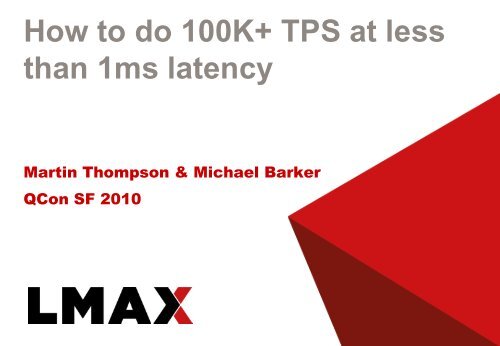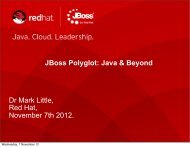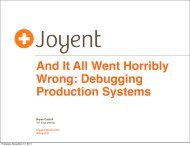How to do 100K+ TPS at less than 1ms latency
How to do 100K+ TPS at less than 1ms latency
How to do 100K+ TPS at less than 1ms latency
Create successful ePaper yourself
Turn your PDF publications into a flip-book with our unique Google optimized e-Paper software.
<strong>How</strong> <strong>to</strong> <strong>do</strong> <strong>100K+</strong> <strong>TPS</strong> <strong>at</strong> <strong>less</strong><br />
<strong>than</strong> <strong>1ms</strong> l<strong>at</strong>ency<br />
Martin Thompson & Michael Barker<br />
QCon SF 2010
Agenda<br />
• Context Setting<br />
• Tips for high performance computing (HPC)<br />
• Wh<strong>at</strong> is possible on a single thread???<br />
• New p<strong>at</strong>tern for contended HPC<br />
• Q & A
Who/Wh<strong>at</strong> is LMAX?<br />
• The Lon<strong>do</strong>n Multi-Asset Exchange<br />
• Spin-off from Betfair in<strong>to</strong> retail finance<br />
• Access the wholesale financial markets on equal terms for retail traders<br />
• We aim <strong>to</strong> build the highest performance financial exchange in the world
Wh<strong>at</strong> is Extreme Transaction Processing (XTP)?<br />
The Internet<br />
The Betfair Experience<br />
v
Wh<strong>at</strong> is Extreme Transaction Processing (XTP)?<br />
The Internet<br />
The LMAX Model<br />
Risky!<br />
L<strong>at</strong>ency<br />
GBP / USD<br />
Spread
<strong>How</strong> not <strong>to</strong> solve this problem<br />
X<br />
X<br />
J2EE<br />
RDBMS<br />
SEDA<br />
X<br />
Ac<strong>to</strong>r<br />
X<br />
X<br />
X X<br />
Rails
Phasers or Disrup<strong>to</strong>rs?
Tips for high performance computing<br />
1. Show good “Mechanical Symp<strong>at</strong>hy”<br />
2. Keep the working set In-Memory<br />
3. Write cache friendly code<br />
4. Write clean compact code<br />
5. Invest in modelling your <strong>do</strong>main<br />
6. Take the right approach <strong>to</strong> concurrency
1. Mechanical Symp<strong>at</strong>hy – 1 of 2<br />
Memory<br />
• L<strong>at</strong>ency not significantly changed<br />
• Massive bandwidth increase<br />
• 144GB in a commodity machine<br />
CPUs<br />
• The GHz race is over<br />
• Multi core<br />
• Bigger smarter caches
1. Mechanical Symp<strong>at</strong>hy – 2 of 2<br />
Networks<br />
• Sub 10 microseconds for local hop<br />
• Wide area bandwidth is cheap<br />
• 10GigE is now a commodity<br />
• Multi-cast is getting traction<br />
S<strong>to</strong>rage<br />
• Disk is the new tape! Fast for<br />
sequential access<br />
• SSDs for ran<strong>do</strong>m threaded access<br />
• PCI-e connected s<strong>to</strong>rage
2. Keep the working set In-Memory<br />
Does it feel awkward working with d<strong>at</strong>a remote from your address space?<br />
• Keep d<strong>at</strong>a and behaviour co-loc<strong>at</strong>ed<br />
• Affords rich interaction <strong>at</strong> low l<strong>at</strong>ency<br />
• Enabled by 64-bit addressing
3. Write cache friendly code<br />
DRAM<br />
DRAM<br />
DRAM<br />
~65ns<br />
DRAM<br />
DRAM<br />
DRAM<br />
MC<br />
QPI ~20ns<br />
MC<br />
L3<br />
~42 cycles ~15ns<br />
L3<br />
L2 L2 L2 L2<br />
L1 L1 L1 L1<br />
~10 cycles ~3ns<br />
~4 cycles ~1ns<br />
L2 L2 L2 L2<br />
L1 L1 L1 L1<br />
C1<br />
C2<br />
C3<br />
C4<br />
Registers
4. Write clean compact code<br />
"Any intelligent fool can make things bigger, more complex, and more violent. It takes<br />
a <strong>to</strong>uch of genius -- and a lot of courage -- <strong>to</strong> move in the opposite direction."<br />
• Hotspot likes small compact methods<br />
• CPU pipelines stall if they cannot predict<br />
branches<br />
• If your code is complex you <strong>do</strong> not properly<br />
understand the problem <strong>do</strong>main<br />
• Nothing in the world is truly complex other<br />
<strong>than</strong> Tax Law
5. Invest in modelling your <strong>do</strong>main<br />
Model of an elephant based on blind men <strong>to</strong>uching one part each<br />
Wall<br />
like a<br />
Rope<br />
<strong>at</strong>tached<br />
Elephant<br />
<strong>at</strong>tached<br />
Snake<br />
Supported By<br />
TreeTrunk<br />
• Single responsibility – One class one thing, one method one thing, etc.<br />
• Know your d<strong>at</strong>a structures and cardinality of rel<strong>at</strong>ionships<br />
• Let the rel<strong>at</strong>ionships <strong>do</strong> the work
6. Take the right approach <strong>to</strong> concurrency<br />
Concurrent programming is about 2 things:<br />
Mutual Exclusion: Protect access <strong>to</strong> contended resources<br />
Visibility of Changes: Make the result public in the correct order<br />
Locks<br />
A<strong>to</strong>mic/CAS Instructions<br />
• Context switch <strong>to</strong> the kernel<br />
• Can always make progress<br />
• Difficult <strong>to</strong> get right<br />
• A<strong>to</strong>mic read-modify-write primitives<br />
• Happen in user space<br />
• Very difficult <strong>to</strong> get right!
Wh<strong>at</strong> is possible when you get this stuff right?<br />
On a single thread you have ~3 billion instructions per second <strong>to</strong> play with:<br />
10K+ <strong>TPS</strong><br />
• If you <strong>do</strong>n’t <strong>do</strong> anything <strong>to</strong>o stupid<br />
<strong>100K+</strong> <strong>TPS</strong><br />
• With well organised clean code and standard libraries<br />
1m+ <strong>TPS</strong><br />
• With cus<strong>to</strong>m cache friendly collections<br />
• Good performance tests<br />
• Controlled garbage cre<strong>at</strong>ion<br />
• Very well modelled <strong>do</strong>main<br />
• BTW writing good performance tests is often harder <strong>than</strong> the target code!!!
<strong>How</strong> <strong>to</strong> address the other non-functional concerns?<br />
• With a very fast business logic thread we need <strong>to</strong> feed it reliably<br />
> Did we trick you in<strong>to</strong> thinking we can avoid concurrent programming?<br />
Network<br />
HA / DR Node<br />
Receiver<br />
Replica<strong>to</strong>r<br />
Network / Archive DB<br />
Publisher<br />
File System<br />
Journaller<br />
Marshaller<br />
Each stage can<br />
have multiple<br />
threads<br />
Un-Marshaller<br />
Pipelined<br />
Process<br />
Business Logic
Concurrent access <strong>to</strong> Queues – The Issues<br />
Link List backed<br />
size<br />
Tail<br />
Node Node Node Node Head<br />
• Hard <strong>to</strong> limit size<br />
• O(n) access times if not head or tail<br />
• Gener<strong>at</strong>es garbage which can be significant<br />
Array backed<br />
Tail<br />
Head<br />
size<br />
• Cannot resize easily<br />
• Difficult <strong>to</strong> get *P *C correct<br />
• O(1) access times for any slot and cache friendly<br />
Cache line
Replica<strong>to</strong>r<br />
Journaller<br />
Un-Marshaller<br />
Marshaller<br />
Disrup<strong>to</strong>r<br />
Network<br />
Network / Archive DB<br />
Receiver<br />
Message<br />
:sequence<br />
:buffer<br />
:invoker<br />
Message<br />
:sequence<br />
:object<br />
:buffer<br />
Publisher<br />
103<br />
7<br />
6<br />
n<br />
5<br />
1<br />
2<br />
3<br />
4<br />
Invoke Stage<br />
Business Logic<br />
n<br />
7<br />
6<br />
5<br />
1<br />
2<br />
3<br />
4<br />
97<br />
long waitFor(n)<br />
long waitFor(n)<br />
101 101 102 :MIN<br />
97 :MIN
Quick Recap<br />
• Most developers have an incorrect view of hardware and wh<strong>at</strong> can be<br />
achieved on a single thread<br />
• On modern processors a cache miss is your biggest cost<br />
• Push concurrency in<strong>to</strong> the infrastructure, and make it REALLY fast<br />
• Once you have this, you have the world th<strong>at</strong> OO programmers dream of:<br />
> Single threaded<br />
> All in-memory<br />
> Elegant model<br />
> Testable code<br />
> No infrastructure or integr<strong>at</strong>ion worries
Wrap up<br />
Q & A<br />
jobs@lmax.com









